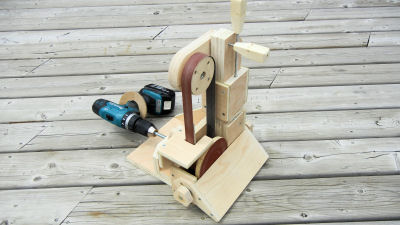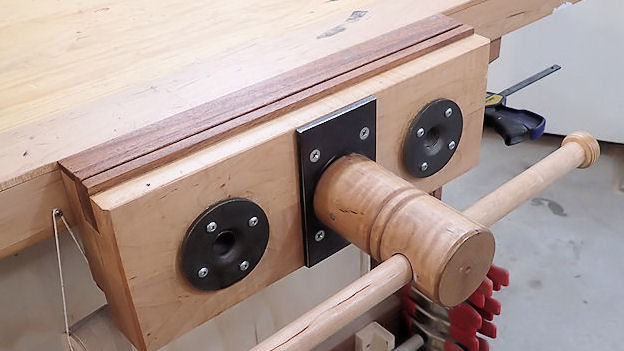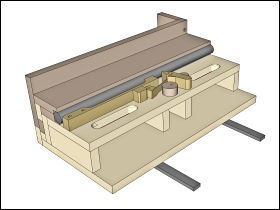Blog: Bracket With Bearing By: John Heisz
To begin, I have to say that this is more of a mini project article than a blog entry. My intention is to move this after I have finished work on the table saws, into two full build articles (one for each table saw). As these are fairly large projects, there will be a few more installments, and each instalment will cover another part of the builds in detail. Until I can get both saws finished, it’s a bit more convenient for me to cover them here, in this blog section.
There will be two saws, with the main, larger one being built around the Delta contractor saw. Although it will be the last one finished, I can do some work to get started on it while I wait for parts to come in for the other saw. Previously, I determined that the pump motor I have is better suited to power the saw, and made a temporary bracket to mount it. I now want to make the permanent bracket, but this one will be made to hold a sealed bearing, to help support the output shaft of the motor. This bearing will take most of the radial load from the drive belt, saving the one that is already installed in the motor.
To get started, I made some measurements at the front of the motor:
.jpg)
There is a ridge that protrudes past the face of the motor, and I need to route the bracket to receive this and the bearing housing, so that the bracket can be bolted on flush.
To do this, I used my homemade compact compass to draw areas that I will route freehand:
.jpg)
.jpg)
This was easy to do and doesn’t need to be perfect, since it only needs to clear the obstructions. I’ve also laid out the pivot point for the bracket and drew an arc around it. Lines are drawn from the edge of the bracket back to the arc at 45 degrees.
.jpg)
On the outer face of the bracket, I laid out the bearing location, again using my compact compass. The bearing I’m using is a high quality sealed bearing that I bought some time ago to use in a wooden band saw build. I haven’t gotten around to the band saw yet, so thought I could use this bearing here and get a new one for the band saw later.
I set the depth of cut on my trimmer router to the effective thickness of the bearing. This leaves the rounded over edge of the bearing proud of the surface after it is pressed in, and I did this because I wanted to maximize the thickness of the plywood behind the bearing for support:
.jpg)
.jpg)
I then routed it out freehand very carefully, checking the size often. The idea is to make a very snug fit for the bearing to prevent it from moving.
The bolts that hold the bracket to the motor are 3/8″, so to give me some room for adjustment, I drilled the holes oversized and counterbored for the washers and heads of the bolts:
.jpg)
.jpg)
With the bolts threaded in loosely, I seated the bearing on the shaft and in the bracket using sockets and a mallet.
.jpg)
.jpg)
After the bearing was installed, I tightened the bolts securely.
There isn’t much shaft left after mounting the bearing, but it’s still enough for the pulley. I did need a spacer washer to go between the bearing and the pulley. The washer keeps the pulley from rubbing on the outer race of the bearing. For this, I had to make my own to fit properly on the shaft. I used a 1/4″ fender washer, clamped that in my vise grips and drilled the hole using two step drills:
.jpg)
.jpg)
The larger step drill made the hole exactly 5/8″:
.jpg)
.jpg)
A snug fit around the shaft and the washer is thick enough to space the pulley, but thin enough that it’s not using up too much space on the shaft.
The original motor had a keyway cut, but on this I decided to just grind a flat spot on the shaft where the set screw presses against it:
.jpg)
I then cleaned the set screw and put some polyurethane construction adhesive on it to act as a semipermanent thread locker:
.jpg)
.jpg)
The adhesive will make it so that the set screw will not come loose, but can be removed if I need to. With the pulley installed, we can see that the shaft was exactly long enough, with none to spare. I started the motor for a quick test.
With the main bracket mounted, I just needed to make the secondary one that clamps around the body of the motor. I used 1/2″ plywood for this, and cut the hole for the pivot point elongated, for adjustment:
.jpg)
.jpg)
The brackets are connected at the pivot point with 1/2″ threaded rod. The threaded rod will also go through the hanger at the back of the saw.
.jpg)
Before going any further, I mounted the motor with the bracket partly assembled to check if there were any clearance issues. I tilted the arbor to 45 degrees to make sure the motor and bracket didn’t extend up over the top of the saw. Better to do this now, rather than finding out later that it doesn’t clear. Luckily, it was fine and the motor is far enough below the top not to interfere with the out feed table.
The hanger holes are bigger than the 1/2″ threaded rod, so I made a collar to take up some of the slack. I made this from aluminum flashing, wrapping it around the rod:
.jpg)
.jpg)
I figure this is something that will eventually wear out, with the threads of the rod cutting into the soft aluminum. Of course, even if it did, that wouldn’t create any major problems and I could easily replace it.
To keep the bracket assembly as simple as possible, I used 3/8″ threaded rod to connect the two parts at the back. To clamp the second bracket tight to the motor body, I used a short turnbuckle:
.jpg)
.jpg)
I then mounted the finished motor assembly onto the saw.
I used six nuts on the threaded rod, with the two on the left side of the hanger jammed against each other to keep the motor in position, but also allow it to pivot:
.jpg)
.jpg)
Simply made, but getting the job done. To keep the motor from jouncing up and down, I will add a tensioner to the bracket during the final build. I will also swap out the v-belt for a link belt.
Shortly after finishing the bracket, I decided to remove the arbor from this saw so that I could find out the size of the bearings to replace them.
I made a video showing the bracket and quickly going through the steps detailed above. Also in the video, I remove the arbor and pull the bearings off:
To watch the latest videos of new projects, subscribe to my YouTube channel.











